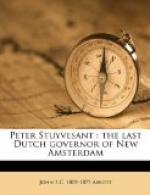Under these circumstances Stuyvesant wrote to Holland for aid. In his letter he said,
“If a farmer cannot plough, sow or reap, in a newly settled country, without being harassed; if the citizens and merchants cannot freely navigate the streams and rivers, they will doubtless leave the country and seek a residence in some place where they can find a government to protect them.’”
The Directors wrote back urging him to employ the Mohawks and other friendly tribes against the Esopus Indians. The governor replied,
“The Mohawks are, above all other savages, a vain-glorious, proud and bold tribe. If their aid be demanded and obtained, and success follow, they will only become the more inflated, and we the more contemptible in the eyes of the other tribes. If we did not then reward their services, in a manner satisfactory to their greedy appetites, they would incessantly revile us, and were this retorted, it might lead to collision. It is therefore safer to stand on our own feet as long as possible.”
The governor had a long controversy with the Massachusetts authorities in reference to its claim to the upper valley of the Hudson. In this he expressed very strongly the title of Holland to the North river.
“Printed histories,” he writes,
“archives, journals, and registers prove that the North river of New Netherland was discovered in the year 1609, by Hendrick Hudson, captain of the Half Moon, in the service and at the expense of the Dutch East India Company. Upon the report of the captain several merchants of Amsterdam sent another ship, in the following year, up the said river. These merchants obtained from the States-General a charter to navigate the same. For their security they erected in 1614, a fort on Castle Island, near fort Orange New Netherland, including the North river, was afterwards offered to the West India Company, who, in the year 1624, two years before Charles I. ascended the throne of England, actually and effectually possessed and fortified the country and planted colonies therein. The assertion that the Hudson river is within the Massachusetts patent granted but thirty-two years ago, therefore, scarcely deserves a serious answer.”
Notwithstanding the undeniable strength of his argument, Governor Stuyvesant felt very uneasy. To his friends he said,
“The power of New England overbalances ours tenfold. To protest against their usurpations would be folly. They would only laugh at us.”
As hostilities still continued with the Esopus Indians, Governor Stuyvesant again visited that post, hoping to obtain an interview with the chiefs, and to arrange a peace. Ensign Smith, with a very strong party of forty men, had utterly routed and put to flight two bands of Indians, one containing fifty warriors, the other one hundred. He took twelve warriors prisoners. They were sent to fort Amsterdam. In the mean time Stuyvesant had succeeded in renewing a treaty of alliance with the Indian tribes on Long Island, Staten Island, and at Hackensack, Haverstraw and Weckquaesgeek. The Long Island Indians consented to send some of their children to fort Amsterdam to be educated.




